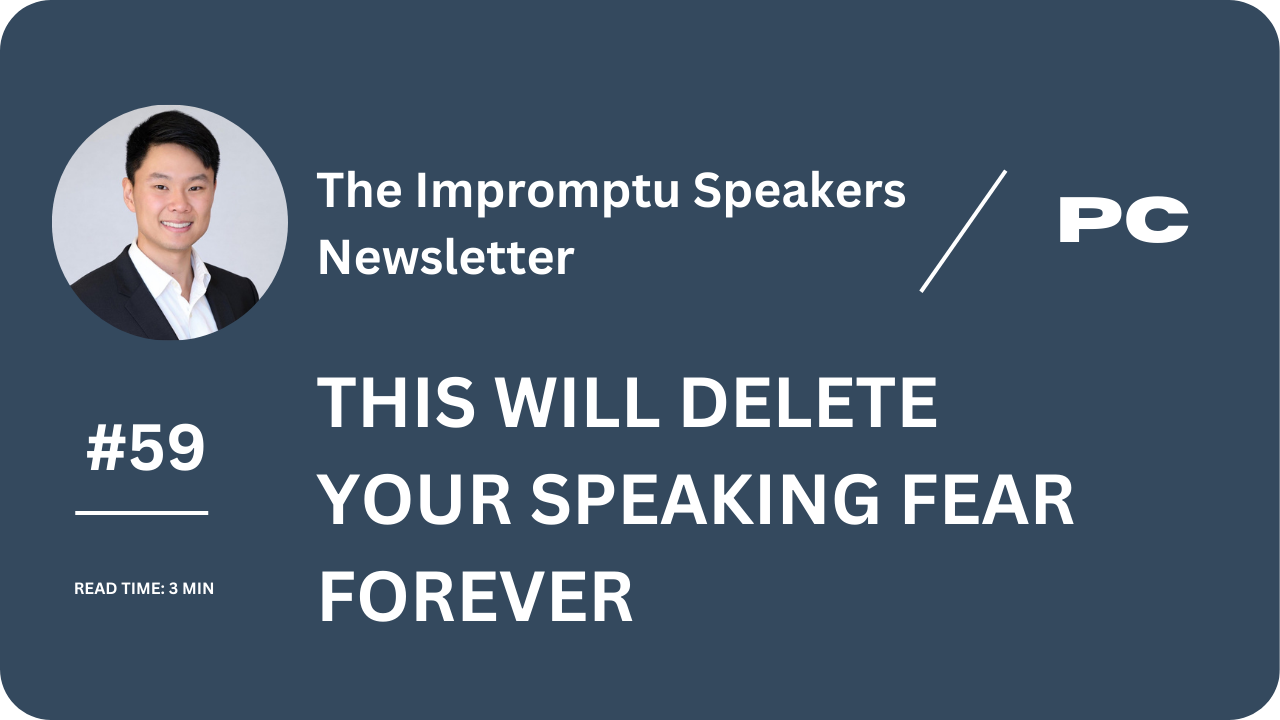This Will Delete Your Speaking Fear Forever

Read Time: 2.5 minutes
Have you ever:
- Dreaded the idea of speaking up at work?
- Felt too anxious before an important speech, presentation, meeting, or interview?
- Declined opportunities to speak because of your fear?
Then keep reading. You'll get a few tactics that -- with enough practice -- will help you completely delete your fear of speaking. They've worked for me and hundreds of my students from Fortune 500 companies.
But here's the main premise. You can't make the fear disappear by "being confident" or "smiling more."
This advice completely misses the real issue.
The truth is that fear and excitement are identical in your body. Both make your heart race, your palms sweat, your chest tighten, and your voice tremble. The only difference?
What your brain tells you about these sensations.
When you're afraid, your brain says "run away." When you're excited, it says "give me more!"
So how do we transform fear into excitement? It's not about surface-level fixes like breathing exercises or standing tall. Those address physical symptoms but not the root cause.
Instead, you need to adjust your mindset before speaking. Here's how:
Two Powerful Techniques to Delete Speaking Fear
1. Pattern Interruption This technique redirects your brain from fear to a specific task. Some people use countdowns (7-6-5-4-3-2-1), but my personal favorite is reciting lyrics from my favorite song.
Without getting too technical, the pattern interruption disrupts our default brain activity. It pivots our focus away from the nervousness and anxiety.
This clears your prefrontal cortex, making room for the next technique.
2. Grounding Visual After your pattern interruption, immediately visualize your ideal outcome in vivid detail.
For example, I coached a senior director who was nervous about building a relationship with her executive. I asked her to close her eyes and imagine what her boss would say after their lunch.
"Thank you for reaching out," "It's great to know you personally," and "I'm excited to work with you on future projects."
She envisioned him shaking her hand and smiling while saying these things.
The key is making it visual and specific. Don't just imagine general success—visualize exact words, handshakes, smiles, and reactions.
Write Your Ideal Outcome
To help create your grounding visual, write down three statements:
- "I want my audience to know _____" (key information)
- "I want my audience to feel _____" (emotion)
- "I want my audience to do _____" (action)
Why is this crucial? Because you tend to lose people. You use too much jargon. You don't focus on what matters.
Instead, you need to simplify your message. Focus on the key information they need to know, the emotion they need to feel, and the action they need to take. I wrote an issue HERE explaining how I used this when I prepared for my last presentation for 300 sales reps.
The Bottom Line
The sequence matters:
- First, develop your grounding visual and internalize it (at least 1 day in advance)
- As your presentation approaches, use your pattern interruption (within 10 minutes)
- While your mind is clear, immediately focus on your grounding visual (within 5 minutes)
Why? It's hard to come up with a grounding visual quickly on the spot. You need to let the visual sit in your mind for several hours. This will make you more ready to internalize the grounding visual once you've done the pattern interruption exercise.
Remember: you can't eliminate fear by telling yourself not to be afraid. Your brain is too smart for that. Instead, acknowledge your body's response and redirect it toward excitement about your ideal outcome.
But mastering this mindset is just the first step. If you want to accelerate your career growth, you need to master the frameworks to become a clear, credible and concise speaker. My most popular course, The Speaker Student Masterclass, will help you get there in ~2 hours. There's a limited time 50% discount inside.

